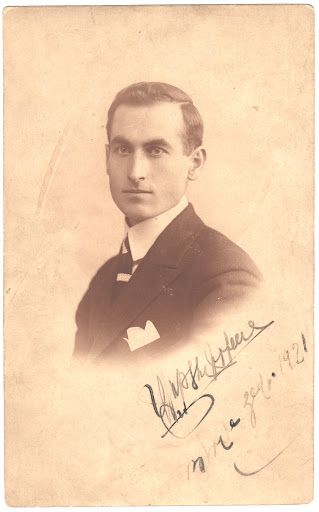The Armenian Genocide of 1915 marked a devastating chapter in history. Over 1.5 million Armenians were systematically exterminated by the Ottoman Empire through deportations, death marches and mass killings. Despite international sympathy, the global response was tepid, offering little accountability for the perpetrators.
In this void of justice, Soghomon Tehlirian, a young Armenian who lost his family in the genocide, became a symbol of his people’s unresolved anguish. His actions in Operation Nemesis — a covert mission by the Armenian Revolutionary Federation (ARF) to eliminate the architects of the genocide — sparked global debate about justice, vengeance and the ethics of violence. By exploring Tehlirian’s journey, the operation’s historical context and the philosophical insights of Paulo Freire and Frantz Fanon, we can better understand the moral complexities of responding to unpunished atrocities.

The transformation of Soghomon Tehlirian
Soghomon Tehlirian’s life was irreversibly shaped by the Armenian Genocide. Born in 1896 in Garin (Erzurum), he witnessed the annihilation of his family during the infamous death marches. These forced marches drove Armenians into the deserts of Syria and Iraq, leading to death by starvation, exhaustion or execution. Survivors described the marches as living funerals — a sentiment reflected in Tehlirian’s haunting visions of his mother’s death.
The orchestrators of the genocide, including Talaat Pasha, faced no legal consequences, finding refuge in foreign countries — with Talaat seeking asylum in Berlin. This lack of justice compelled Tehlirian and the ARF to act. By 1920, Tehlirian had joined Operation Nemesis, a mission driven by the conviction that the world’s inaction left Armenians no choice but to seek their own justice.
What was Operation Nemesis?
Operation Nemesis emerged as a response to the international community’s failure to prosecute the masterminds of the Armenian Genocide. Talaat Pasha, the former Ottoman Minister of the Interior and chief architect of the genocide, epitomized this impunity. Living freely in Berlin, Talaat’s escape symbolized the world’s indifference to Armenian suffering.
The ARF meticulously planned Talaat’s assassination, assigning Tehlirian as the executor. On March 15, 1921, Tehlirian intercepted Talaat on a Berlin street and shot him at point-blank range. Tehlirian allowed himself to be apprehended, setting the stage for a trial that would shift global focus from the act of assassination to the genocide itself.
The operation was not merely an act of vengeance but a calculated effort to demand accountability and reignite discourse on the atrocities of 1915.
Tehlirian’s trial
Tehlirian’s trial in Berlin became a platform for exposing the Armenian Genocide to an international audience. The defense reframed the case as a moral reckoning, emphasizing Tehlirian’s psychological trauma and Talaat’s crimes. Testimonies detailed the horrors of the death marches and mass killings, shifting the narrative from Tehlirian’s culpability to the genocide’s unpunished atrocities.
In a landmark decision, the German court acquitted Tehlirian, stating his actions were driven by psychological compulsion stemming from trauma. The verdict was a symbolic acknowledgment of the genocide and the complexities of retributive justice. While celebrated by Armenians as a moment of vindication, the decision raised ethical questions: Can violence ever be justified as a response to systemic injustice?
Understanding Operation Nemesis through Paulo Freire and Frantz Fanon
The works of Paulo Freire and Frantz Fanon provide valuable frameworks for understanding Operation Nemesis. In Pedagogy of the Oppressed, Freire argues that violence is inherent in systems of oppression, dehumanizing both the oppressed and the oppressors. For Freire, the violence of the oppressed is not an initiation but a reaction to systemic injustice to reclaim humanity when dialogue and justice are denied. He asserts, “Never in history has violence been initiated by the oppressed. How could they be the initiators if they themselves are the result of violence?”
Similarly, Fanon’s The Wretched of the Earth explores violence as an inevitable outcome of colonial oppression. He describes revolutionary violence as a means of reclaiming agency and identity, asserting, “Violence is man recreating himself.” For Fanon, such acts are not glorifications of violence but necessary ruptures in oppressive systems.
These perspectives frame Operation Nemesis not as isolated vengeance but as a response to systemic dehumanization. Tehlirian’s actions, while violent, were part of a broader struggle to challenge the erasure of Armenian identity and demand accountability when legal systems failed.
Reassessing justice and violence
Operation Nemesis forces us to grapple with uncomfortable truths about justice and morality. For Armenians, the operation symbolized resistance against global silence and a refusal to let Talaat Pasha’s crimes go unpunished. Freire and Fanon’s philosophies underscore that acts of counter-violence, while morally complex, often arise from systemic injustice and a lack of alternatives.


Bravo.
A big fan of Frantz Fanon. Amazing writing!!